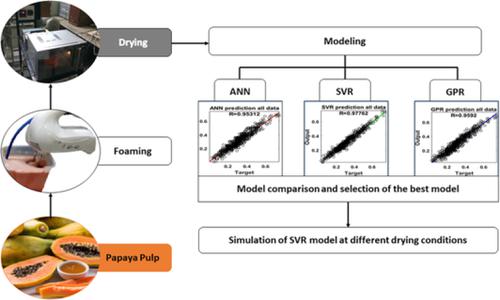当前位置:
X-MOL 学术
›
J. Food Process Eng.
›
论文详情
Our official English website, www.x-mol.net, welcomes your
feedback! (Note: you will need to create a separate account there.)
Foam mat drying of papaya using microwaves: Machine learning modeling
Journal of Food Process Engineering ( IF 2.7 ) Pub Date : 2020-02-24 , DOI: 10.1111/jfpe.13394 Ovais S. Qadri 1, 2 , Khwaja Osama 3 , Abhaya K. Srivastava 2
Journal of Food Process Engineering ( IF 2.7 ) Pub Date : 2020-02-24 , DOI: 10.1111/jfpe.13394 Ovais S. Qadri 1, 2 , Khwaja Osama 3 , Abhaya K. Srivastava 2
Affiliation

|
The aim of this article is to study the microwave‐assisted foam mat drying of papaya to form papaya powder. The process of foam mat drying of papaya using microwaves was modeled by machine learning approaches like artificial neural network (ANN), support vector regression (SVR), and Gaussian process regression (GPR). Effect of microwave power (480–640 W), inlet air temperature (40–50°C), and thickness of foam (2–4 mm) on the rate of drying were studied. The performance of the models was evaluated on the basis of different performance matrices including root mean square error (RMSE), coefficient of determination (R2), model predictive error, and Chi‐square (χ2). The microwave heating of the papaya foam reduced the drying time manifold. All three machine learning approaches were able to predict the drying process efficiently. SVR showed the best performance (R2 = 0.96; RMSE = 0.03) followed by GPR (R2 = 0.92; RMSE = 0.04) and ANN (R2 = 0.91; RMSE = 0.04). SVR‐based model was simulated to predict the effect of power, temperature, and thickness on drying rate. Machine learning approaches can be efficiently used for modeling and microwave‐assisted foam mat drying. SVR‐based model proves to be a good alternative of ANN.
中文翻译:

使用微波干燥木瓜的泡沫垫:机器学习建模
本文的目的是研究木瓜的微波辅助泡沫垫干燥,以形成木瓜粉。通过机器学习方法,如人工神经网络(ANN),支持向量回归(SVR)和高斯过程回归(GPR),对使用微波对木瓜进行泡沫垫干燥的过程进行了建模。研究了微波功率(480–640 W),进气温度(40–50°C)和泡沫厚度(2-4 mm)对干燥速率的影响。所述模型的性能的不同性能的基质包括根均方误差(RMSE),确定(的系数的基础上进行评价- [R 2),模型预测误差,和卡方(χ 2)。木瓜泡沫的微波加热减少了干燥时间。三种机器学习方法均能够有效预测干燥过程。SVR显示最佳性能(R 2 = 0.96; RMSE = 0.03),其次是GPR(R 2 = 0.92; RMSE = 0.04)和ANN(R 2 = 0.91; RMSE = 0.04)。模拟了基于SVR的模型,以预测功率,温度和厚度对干燥速率的影响。机器学习方法可以有效地用于建模和微波辅助泡沫垫干燥。事实证明,基于SVR的模型是ANN的良好替代方案。
更新日期:2020-02-24
中文翻译:

使用微波干燥木瓜的泡沫垫:机器学习建模
本文的目的是研究木瓜的微波辅助泡沫垫干燥,以形成木瓜粉。通过机器学习方法,如人工神经网络(ANN),支持向量回归(SVR)和高斯过程回归(GPR),对使用微波对木瓜进行泡沫垫干燥的过程进行了建模。研究了微波功率(480–640 W),进气温度(40–50°C)和泡沫厚度(2-4 mm)对干燥速率的影响。所述模型的性能的不同性能的基质包括根均方误差(RMSE),确定(的系数的基础上进行评价- [R 2),模型预测误差,和卡方(χ 2)。木瓜泡沫的微波加热减少了干燥时间。三种机器学习方法均能够有效预测干燥过程。SVR显示最佳性能(R 2 = 0.96; RMSE = 0.03),其次是GPR(R 2 = 0.92; RMSE = 0.04)和ANN(R 2 = 0.91; RMSE = 0.04)。模拟了基于SVR的模型,以预测功率,温度和厚度对干燥速率的影响。机器学习方法可以有效地用于建模和微波辅助泡沫垫干燥。事实证明,基于SVR的模型是ANN的良好替代方案。
















































 京公网安备 11010802027423号
京公网安备 11010802027423号